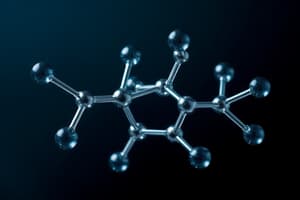Podcast
Questions and Answers
The location of the double bonds is indicated after the parent name.
The location of the double bonds is indicated after the parent name.
False (B)
Alkanes are aliphatic hydrocarbons with at least one C-C double bond.
Alkanes are aliphatic hydrocarbons with at least one C-C double bond.
False (B)
The prefix 'eth-' represents three carbon atoms in the main chain.
The prefix 'eth-' represents three carbon atoms in the main chain.
False (B)
Cycloalkanes are alicyclic hydrocarbons that contain one or more closed rings of carbon atoms.
Cycloalkanes are alicyclic hydrocarbons that contain one or more closed rings of carbon atoms.
The suffix for the highest bond order in hydrocarbons containing triple bonds is -ane.
The suffix for the highest bond order in hydrocarbons containing triple bonds is -ane.
Most aromatic hydrocarbons contain a benzene ring.
Most aromatic hydrocarbons contain a benzene ring.
The prefix 'tri-' indicates four repeating units in a hydrocarbon compound.
The prefix 'tri-' indicates four repeating units in a hydrocarbon compound.
Alkanes contain carbon-carbon double bonds.
Alkanes contain carbon-carbon double bonds.
Alkynes are aliphatic hydrocarbons that contain a C-C triple bond.
Alkynes are aliphatic hydrocarbons that contain a C-C triple bond.
Saturated hydrocarbons have all carbon-carbon bonds as double bonds.
Saturated hydrocarbons have all carbon-carbon bonds as double bonds.
A molecule with the chemical formula $C_{2}H_{4}$ is an alkene.
A molecule with the chemical formula $C_{2}H_{4}$ is an alkene.
Aliphatic hydrocarbons are based on chains of O atoms.
Aliphatic hydrocarbons are based on chains of O atoms.
Saturated hydrocarbons contain at least one double or triple bond between carbon atoms.
Saturated hydrocarbons contain at least one double or triple bond between carbon atoms.
Unsaturated hydrocarbons can be classified as alkenes, aromatic hydrocarbons, or alkynes based on the number of bonds between neighboring carbon atoms.
Unsaturated hydrocarbons can be classified as alkenes, aromatic hydrocarbons, or alkynes based on the number of bonds between neighboring carbon atoms.
Alkanes have at least one double bond between carbon atoms.
Alkanes have at least one double bond between carbon atoms.
Alkenes contain at least one triple bond between carbon atoms.
Alkenes contain at least one triple bond between carbon atoms.
Alkynes have at least one triple bond between carbon atoms.
Alkynes have at least one triple bond between carbon atoms.
IUPAC naming system is used to identify hydrocarbon molecules and follows specific rules to ensure each molecule has a unique name.
IUPAC naming system is used to identify hydrocarbon molecules and follows specific rules to ensure each molecule has a unique name.
Flashcards are hidden until you start studying
Study Notes
Alkanes
- Aliphatic hydrocarbons with at least one C-C double bond.
- Contain carbon-carbon double bonds.
Alkynes
- Aliphatic hydrocarbons containing a C-C triple bond.
- Have at least one triple bond between carbon atoms.
Alkenes
- Contain at least one triple bond between carbon atoms.
- A molecule with the chemical formula $C_{2}H_{4}$ is an alkene.
Cycloalkanes
- Alicyclic hydrocarbons containing one or more closed rings of carbon atoms.
Aromatic Hydrocarbons
- Most contain a benzene ring.
Saturated Hydrocarbons
- Contain all carbon-carbon single bonds.
Unsaturated Hydrocarbons
- Contain at least one double or triple bond between carbon atoms.
- Can be classified as alkenes, aromatic hydrocarbons, or alkynes based on the number of bonds between neighbouring carbon atoms.
IUPAC Naming System
- Used to identify hydrocarbon molecules.
- Follows specific rules to ensure each molecule has a unique name.
Naming Rules
- The prefix 'eth-' represents three carbon atoms in the main chain.
- The prefix 'tri-' indicates four repeating units in a hydrocarbon compound.
- The suffix for the highest bond order in hydrocarbons containing triple bonds is -ane.
- The location of the double bonds is indicated after the parent name.
Studying That Suits You
Use AI to generate personalized quizzes and flashcards to suit your learning preferences.




